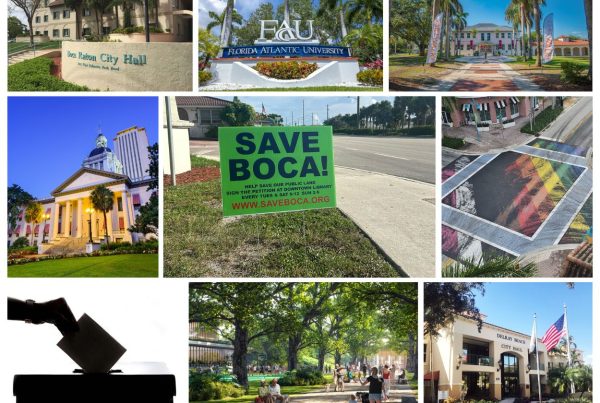Houston’s: the back story
The deal to put a Houston’s restaurant on the Wildflower property in Boca Raton is not dead. But it does need a nudge.
Two weeks ago, in a letter to Deputy City Manager George Brown, Hillstone Vice President Glenn Viers said the company was “withdrawing its proposal” to lease the site. The decision came as a surprise, and it didn’t make sense; the company has two years of time and expense in the project. The city council’s tepid reaction at a workshop meeting four days later also seemed puzzling. Council members sounded almost indifferent to the possible failure of the council’s top priority for two years.
My sense after speaking with Viers and some council members is that each side is waiting to hear from the other. “I don’t know how real the letter (from Hillstone) is,” Councilman Mike Mullaugh said. “I expect a follow-up.” Viers said no follow-up is planned, but when I asked if the company might want to re-engage with the city, he said, “Talking is always better than not talking.”
Part of the problem is Boca Raton’s manager-council form of government. Susan Haynie is a “weak” mayor, whose main powers apart from the other council members are running the meetings and working with City Manager Leif Ahnell to set the agenda. Ahnell is the city’s CEO.
As such, Haynie and the council had to delegate negotiations to staff, and then wait for a lease agreement that the council would approve or reject. Even now, council members aren’t sure why the talks broke down.
Viers and Brown confirmed that the main problem was the city’s demand for a two percent annual increase in the initial lease payment of $500,000. The draft agreement had contained a five percent increase every five years. The city wanted to double that increase.
A related problem was the potential property tax bill. Though the city owns the site, Hillstone as a private entity in a long-term ground lease would pay the taxes. The assessed value of the 2.3-acre property—the amount on which taxes are calculated—rose 10 percent in the last year —from $6 million to $6.6 million. As Viers correctly points out, that valuation is just for the land on the Intracoastal Waterway. It would rise even more with a Houston’s on it.
Councilman Robert Weinroth said the explanation from the staff was “kind of confusing to listen to.” Scott Singer is “waiting for more information,” to “get a better handle” on things. Of the two percent demand, Mullaugh said, “I don’t know how that all happened.” Haynie said the letter “caught us all off-guard.” She would like to “identify where the gap is. How far apart are we?”
To find out, the council may need to reach beyond the staff. The Greater Boca Raton Chamber of Commerce, Haynie said, has offered to help resolve the dispute. Some chamber members, Haynie said, understand ground leases, and could help the city determine if its offer is realistic. Chamber leaders understandably worry that failure to reach a deal on the Wildflower property with the city’s chosen company after all this time would hurt Boca Raton’s reputation as a city that encourages business development.
Another issue may be the dock that Haynie and others hoped the restaurant would add for diners to come by boat. Viers said Hillstone’s engineers have told him that currents in the area make a dock too risky compared to the section of the Intracoastal in Pompano Beach where Hillstone operates a Houston’s that has a dock. Again, the council needs more information.
Nothing I’ve heard from either side suggests that the problems are insurmountable. Hillstone owns the site of its Houston’s near Town Center Mall, so property taxes haven’t kept that restaurant from succeeding. Four of the five council members say they would consider continuing the talks. In Hillstone, Boca has a top-tier company to create the private-public space the city wanted.
If the letter was a negotiating tactic, it got the council’s attention. Haynie has the right attitude: “Let’s see if we can salvage this deal.”
The park option
Now that we have discussed what should happen with the Wildflower property, let’s discuss what should not happen: The city council should not even think of making the site into a park.
During public comment at last week’s council meeting and at the previous day’s workshop, several speakers urged the council to abandon the idea of a restaurant. Some referred to “Wildflower Park.” They claimed that the public supports use of the site as a passive park. One man asked, “How can you not listen to us?”
One reason is that “us” consists almost entirely of people who live near the property and don’t want it developed. They fear more traffic. It’s a legitimate concern, but the city has been working to address it. Other speakers said a park would draw people to downtown stores and that crime had increased because of higher population density. Both are bogus claims.
The key point is that Boca Raton did not spend $7.5 million to create a little-used pocket park. Then-Mayor Susan Whelchel said the plan was for a restaurant with a public walkway along the Intracoastal. When the council approved the purchase in December 2009, outdoor dining was part of the discussion. When staff began negotiations with Hillstone almost two years ago, a memo from Deputy City Manager George Brown noted that the council at its May 2013 goal-setting session had emphasized developing the Wildflower property for “income production.”
Yet some of the regulars at council meetings keep insisting that developing a restaurant would be breaking faith with the public. The public, however, also includes the great majority of residents who don’t live near the site and expect the city to get a return on their investment.
Consider that even with just a $500,000 annual payment from Hillstone over the 20 years of the lease, the city would receive one-third more than the purchase price. The city also would get a destination that might actually draw people to downtown merchants and would draw new downtown residents without them having to drive.
Seeing Hillstone’s letter, opponents of the restaurant now want the city to open the site to the public—just for a little while. Take down the fence. Put down some sod. Councilman Jeremy Rodgers was their advocate last week. City Manager Leif Ahnell may have projected costs for next week’s council meeting.
As Mayor Susan Haynie noted, however, it’s not that simple. The site would have to be Americans With Disabilities Act-compliant. Where would people park? What about liability issues?
Opening the site also would show the city caving to a vocal, naysaying minority. And 2016 isn’t even an election year. Further, no-growth candidates who got support from no-growthers opposed to developing the Wildflower site have lost in the last two city elections.
Boca Raton has many parks—and any money for parks should be spent on them. The Wildflower site may look ugly now, but the consequences would be uglier if the council gave in. Close the Hillstone deal, and take down the fence when the construction workers show up.
Lynn largesse
Florida Atlantic University has raised half of the money for what President John Kelly calls FAU’s “transformative” project.
That would be the Schmidt Family Complex for Academic and Athletic Excellence. Eleven months ago, FAU announced the $16 million gift from the Schmidt Foundation that started the fund-raising drive. On Tuesday, the stage belonged—as it so often does—to the relentlessly charitable Christine E. Lynn.
The gift is $5 million from the E.M. Lynn Foundation, named for Ms. Lynn’s late husband, Eugene Lynn. With the donation, according to Athletic Director Pat Chun, FAU has raised $23 million. The projected cost is between $45 million and $50 million.
Kelly intends for the complex to be a marketing tool— aimed both at student-athletes seeking an advanced training and rehab facility and non-athlete students who want to major in a sports-related discipline.
FAU threw a nice announcement party. It took place in the Delray Acura Club on the third floor of the football stadium. Invitees included professors who would teach at the complex and faculty members of the nursing school, to which Ms. Lynn—a former nurse—also donated $350,000. Though the football team is just 2-6, Kelly touted the Owls’ victory last Saturday over Florida International in the annual Shula Bowl.
Though FAU has fielded a football team for less than two decades, Kelly believes that a consistent winner will help to attract students and promote the Schmidt complex. In his remarks Tuesday, Kelly said FAU wants to model the University of Memphis.
Both schools are in the so-called second tier of national conferences—FAU in Conference USA and Memphis in the American Athletic Conference. Just four years ago, Memphis fired a coach who had gone 3-21. Attendance was low. This year, Memphis is 8-0, and has a signature win over the University of Mississippi of the SEC, one of the “Power Five” conferences.
Amid all the fun on Tuesday, Richard Schmidt reminded everyone of what remains. Thanking Ms. Lynn, expressing hope for what the complex could bring, Schmidt said, “One day, we’ll look back, hopefully in not too many years. . .” Chun said FAU is “knee-deep” in fund-raising. Good. No one missed Schmidt’s hint.
Zoning change?
After the Boca Raton City Council approved the Chabad East Boca project, Mayor Susan Haynie said the city would look at the zoning designation that allows commercial development next to neighborhoods. The chabad will be across the street from residences just south of East Palmetto Park Road.
A proposed change is before the planning and zoning board tonight. It will be interesting to see what the board members decide. What can seem like a simple change – in this case with the idea of protecting neighborhoods – can irritate property owners.
Ask first
Here’s a good Boca story:
My wife and I were dining at a Mizner Park restaurant this week. Before he removed our wine glasses, the waiter noticed that I had a sip left. Would I like it? I would.
I thanked him. He replied that it was part politeness and part self-preservation. Not long before, he had removed a glass too soon. The customer, he said, “nearly took my arm off.”








